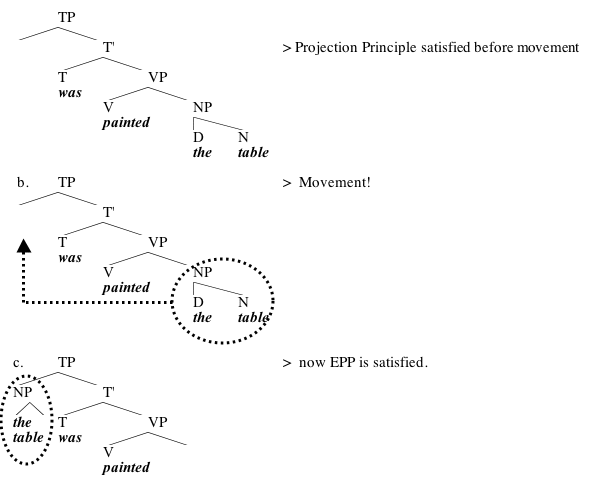
(1) John painted [the table] [in an hour]
(2) *John painted [in an hour] [the table]
Since paint selects for the NP the table, the NP will have to be the sister of V, and will therefore have to be closer to V than the adjunct PP in an hour.
If we passivize (1), however, it looks like we have an problem:
(3) [the table] was painted.
In (3), the complement of the verb seems to be nowhere near it; in fact, if we're drawing the tree for (3) correctly, the NP selected by the verb is in the specifier of TP. How does this happen?
There are at least two imaginable strategies for dealing with this apparent violation of the Projection Principle:
(4) a.

At the beginning of this derivation, the Projection Principle is satisfied; the phrase selected by the verb, the table, is the sister of the verb. By the end of the derivation, the EPP is satisfied; the specifier of TP is occupied.
There are a number of arguments that this is the correct analysis of passives. Here are a few of them:
These are all arguments that the sentence in (3) ought to be associated with the trees in (4); that the subject of a passive actually begins in object position (where the Projection Principle requires it to be) and that an operation of movement takes it from that position to the specifier of TP. Now, why does this movement operation take place?We already have one way of forcing it to take place; the EPP requires the specifier of TP to be occupied. But actually, there's some reason to think that the EPP by itself won't be enough to account for all the facts about passives. Consider examples like (5):
(5) John told Mary about Syntax.
In principle, we could imagine two kinds of passive sentences that we could make out of (5):
(6) Mary was told about Syntax.
(7) *About Syntax was told Mary.
In both of (6-7), the specifier of TP is empty, and must be filled. And in both examples, something moves to fill the specifier of TP: the NP Mary in (6), and the PP about Syntax in (7). So the EPP ought to be satisfied in both of these examples, but apparently something has gone wrong with (7). This was the type of problem that led, in the '70s, to the development of Case Theory, which is our next stop.